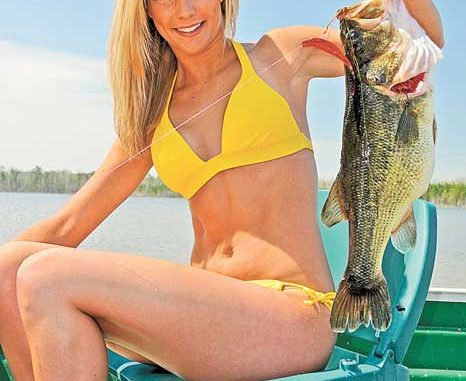
Soak a dead shrimp or live crawfish on the bottom of Lake Pontchartrain, and you’ll be surprised what you pull up.
This month we’ll be fishing D’Arbonne Lake, located near Monroe, where the bass will be in the post-spawn period. There still may be remaining shad spawning, but the bass will be migrating out to the creek channels — usually headed to the first ditch just off the spawning flats.
I’ll begin fishing in the mornings, looking for bass in the backs of pockets, by starting at the ends of the ditches and fishing outward. By studying Lake D’Arbonne, you’ll see it’s a structure fisherman’s dream with its tremendous number of ditches, big stump flats with ditches running through them and pockets.
Buzzes and spinners
Although the main D’Arbonne channel runs through the lake, I’ll start hunting bass in the back ends of feeder creeks that run into the main channel.
Early in the morning, I’ll start fishing shallow. I’ll hold my boat in the ditch and cast toward wood targets with a 1/2-ounce white Strike King buzz bait. I’ll use this bait because the bass will be feeding heavily on shad this month.
Also, I’ll be fishing a 1/2-ounce Strike King Premiere Elite spinner bait with a No. 4 and 4 1/2 willowleaf blade and either a white, white/chartreuse or sexy shad-colored skirt. With my lure selection, I want to imitate the shad the bass will be eating.
The weather will determine how long you can stay with the buzz bait and spinnerbait, and still have success. This month the weather will be warm, but not hot. So, on a good day, you can fish with these two lures all day and catch bass, especially if the day’s cloudy with a little bit of wind, and the weather isn’t extremely hot.
I’ll be fishing the buzz bait and the spinnerbait fairly fast, trying to trigger a reaction bite from the bass holding on the wood cover.
Crankbaits
If we don’t have clouds and wind later in the morning, I’ll move out to deeper water, and search for turns and bends in those underwater ditches and secondary creek channels. Also, I’ll be looking for little underwater points that stick out into those feeder creeks.
When I find these kinds of underwater structures, I’ll switch to a Strike King Series 5 crankbait in blue/chartreuse or sexy shad. I’ll fish these crankbaits on bigger line than you normally fish crankbaits, using 17- or 20-pound-test Cajun fluorocarbon line.
My boat will be sitting in a ditch, which will be 8 to 10 feet deep, and I’ll be casting into 4- to 5-foot-deep water. The heavier line allows the crankbait to run only about 5 or 6 feet deep.
I’ll cast to the shallow water, and expect the bass to bite as the crankbait comes over the lip of the break along the edges of those underwater drop-offs. I’ll start in the back end of a creek and then work my way out of the creek to the point where it runs into the main channel.
Generally in May, the bass haven’t moved out to the main bayou channel where they’ll hold in their summer pattern.
Big plastic worm
If I strike out with the crankbait, my next go-to lure is a big, plastic worm. For some reason, after the bass spawn, the weather starts to warm and the bass are suspended, they really like a big, slow-falling plastic worm with a lot of action. I prefer the 10-inch Strike King Rage Anaconda on a relatively light sinker with a 3/8-, 5/16- or 1/4-ounce Tru Tungsten sinker fished on 17- or 20-pound-test line. I also peg my sinker to the head of my worm. The Anaconda has action in the tail of the bait, and if you don’t peg the lead to the head of the worm, the sinker will fall away from the worm, and you won’t get the proper fall out of the bait.
At this time of year, the bass are recovering from the spawn, and they like big baits that are easy to see and eat, which is why I like big buzz baits, spinnerbaits, crankbaits and worms. All these baits offer the bass a big meal in one bite.
I prefer bug-colored Anaconda worms this month, such as red bug and Bama bug. I also like natural colors, but I want the worm to have flash in it. Both these colored worms have a lot of metal flake in them.
D’Arbonne has produced bass up to 15 pounds. Although you can’t bet on catching a 12- to 15-pounder, there’s plenty of bass in the 2- to 5-pound range, and you may catch a fish of a lifetime.
Right now, D’Arbonne is a healthy fishery because it had a huge drawdown last winter. Bass usually will have a really good spawn after a lake has been drawn-down during the winter months. The ground being exposed to the sunlight during the drawdown may increase the nutrients or better utilize the nutrients in the bottom of the lake.
In many lakes, bass fishing is generally slow immediately after a drawdown and after the water rises. But by May, the water will have been at normal pool for 4 or 5 months, and the bass will have become more accustomed to those conditions.


